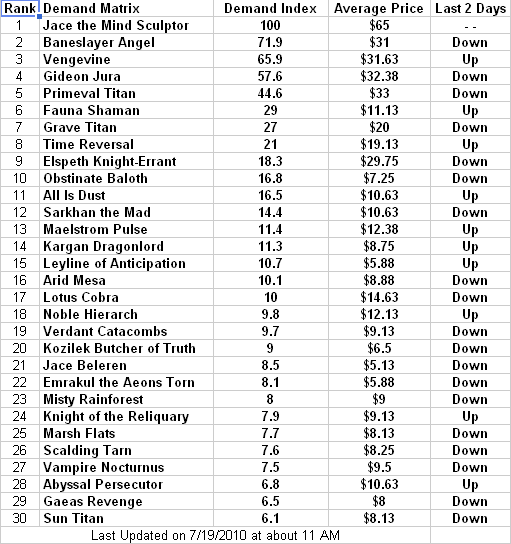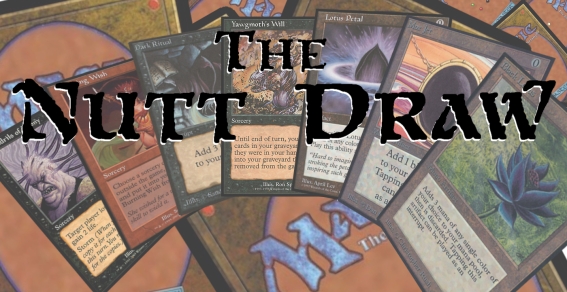Are you a Quiet Speculation member?
If not, now is a perfect time to join up! Our powerful tools, breaking-news analysis, and exclusive Discord channel will make sure you stay up to date and ahead of the curve.
How is the value of a card determined? The short and simple answer is that it’s a combination of supply & demand, playability and hype. Even though this is absolutely true it doesn’t tell us anything. How do you accurately quantify hype, count up the times Jace, The Mind Sculptor is mentioned by Patrick Chapin and Conely Woods and divide by 2?
How do you measure supply and demand, make some educated guesses about print runs, geographical distribution and multiply that by the hype? What about playability, do we count the copies in all the top 8 decks? Any of these methods would hint at the results we’re looking for, but none would be very accurate and with no points of reference, they would be fairly useless.
A little caveat I need to add here is that the spreadsheet, charts and graphs that I link to all have live data, so the information in them may be more current then my commentary.For the purposes of my articles, I’m going to rely on any solid data I can my geeky little hands on, namely, eBay sales and online store pricing. The current snap shot of the card values in Standard are about what you would expect. The most valuable ($$) cards at are currently Jace, The Mind Sculptor, Gideon Jura, Vengevine and Baneslayer Angel.
It’s pretty obvious why these are sought after, but what makes the average price of Jace, The Mind Sculptor $66 on eBay ($81 average in tracked online stores)? There has been a lot of discussion about these high dollar cards but it’s mostly guesswork and conjecture. I’m developing a hypothesis and gathering data about the maximum pricing threshold of any given card in print, but to prove the validity of an $80 Jace I’ll look at some sales data. In Magic, the demand part of supply & demand is basically a capitalistic vote. We vote with every dollar we spend and I was surprised at how many votes are going to the Mind Sculptor. It’s a great card but I was a little shocked at the amount of proportional money being spend on him. For example, even at its current value, our Magic brethren have been buying more than 43 copies a day over the last week, and for every $1 spent on a Jace, 77 cents are spent on Gideon Jura, 89 cents on Vengevine, 53 cents on Baneslayer Angel. Of the 30 or so most expensive cards in standard more money is spent daily on Jace than any other chase card. Lotus Cobra is a staple card in the current format, but only about 23 were purchased daily in the same time frame and at only 12% of the price. It may be a little confusing to think of demand in these terms, but with the data I have access to, voting by the dollar seems the best tape measure.
Another example would be Nicol Bolas, Planeswalker. He’s currently the 17th most expensive card in Standard at $9.25 placing him just above Knight of the Reliquary and all the fetch lands. By his price alone you might think that everyone out there was trying to complete a playset or expand their Nicol Bolas papier-mâché project if he’s more valuable the fetch lands. However, dollar for dollar, Jace is purchased 58 times more than poor Mr. Bolas. These calculations may change over time, but for now and in order to solve this popularity contest, I’m going to organize these values into something I call The Demand Matrix.

I believe this to be best snapshot of the demand and activity of the cards in Standard that most of us are likely to get. All the numbers are calculation driven from real sales figures so they are pretty impartial and represent some tangible evidence that goes a little way to justifying the prices put on the top cards. In case you’re interested to know how I came up with these figures, I’m looking at the individual cards sales figures for the last week and whatever card has the most average daily spend is established as 100% demand. All other values are the percentage of daily average sales in dollars over the same time period.
With the pre-release of M11 looming I need to spend a little time charting the emerging landscape. As with all the sets since Zendikar, I have been tracking the pre-order sales on eBay and the pre-sale pricing on a few web sites in order to give my friends and the community some card value guidance as they venture forth to trade and conquer. Baneslayer Angel is the most valuable card in the set and a few of the hyped spoilers are gonna dent some pocketbooks such as Primeval Titan, Time Reversal, and Grave Titan. I’m not the person to ask about what a card's value might be later, but I demonstrate some of the recent trends.
Time Reversal has been mostly going down in price since it was spoiled and was valued over $20 about a week ago and is now below $15. Primeval Titan and Grave Titan have been more or less holding value at $20-$25 and $10-$13 respectively.
All the M11 pricing data can be found right here and will continue to be updated until the release of M11 so keep it handy. I’ll finish up by giving you one last thing to make you go “hmm".
Born in Seattle, Washington, Chris McNutt has been playing and collecting Magic: The Gathering since Unlimited Edition. As an active player, tournament organizer and judge he regularly scrubs out of Pro Tour Qualifiers but inexplicably cleans up at the local draft tables. When not net decking Chris is either busy working as an Information Technology Sales Rep or spending time with his family. Other non-magical pastimes include playing guitar and an unhealthy number of video games. Cursed with an undying love of generating spreadsheets purely for "fun", he'll be crunching the numbers each week in order to serve up delicious data burritos to the salivating, hungry readers of Doubling Season.







That's interesting to look at the demand as a % of dollars. Doesn't the high price of jace skew that demand a bit? If people are spending 91% of the money on Vengevines as they are on Jace and the vine is half the price doesn't that mean the vine is actually in higher demand, or does that only mean that it's twice as liquid?
When I was maintaining a buy list for my store we used an A-E system for demand as part of a risk curve. "A" cards were the most liquid so often we had to pay more for them, and we rarely bought anything under a "C". I'm tempted to pull out the old guidelines and see if there is a corresponding DV that would make sense with that model.
I guess I'm looking at demand as desire for the card without looking at the price which is actually just liquidity. Saying everyone wants Jace isn't the same thing as everyone wants Jace, but those with $60 proved it.
@Paul
Though I’ve worked with buy lists as a consumer I haven’t been in the position of needing to build a one for a shop yet so I’d be curious to see the A-E system guidelines in order to match it up with something that is strictly numerical. I’m still toying with the formulas and equations a bit, but my next article will be primarily focused on this new way of rating a card.
@Paul
Though I've worked with buy lists as a consumer I haven't been in the position of needing to build a one for a shop yet so I'd be curious to see the A-E system guidelines in order to match it up with something that is strictly numerical. I'm still toying with the formulas and equations a bit, but my next article will be primarily focused on this new way of rating a card.